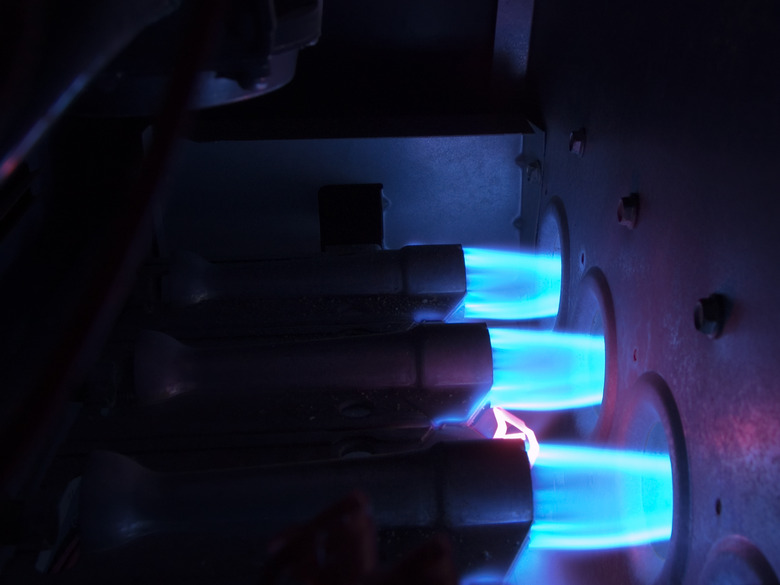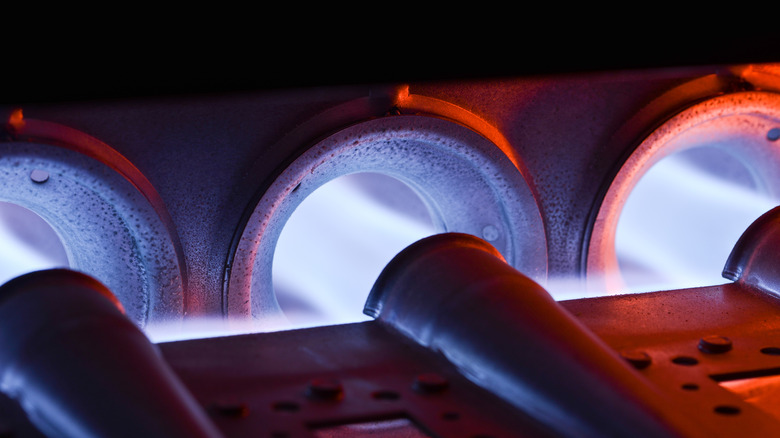How To Clean Gas Furnace Burners
We may receive a commission on purchases made from links.
Cleaning gas furnace burners is a part of a professional furnace tune-up, but since dirty burners can reduce the efficiency of your furnace and keep you in the cold, you might not want to wait for an HVAC technician to clean them. It's a DIY job, but to do a thorough job, some disassembly is required, and that can be more or less extensive depending on the model. If you're lucky, you'll be able to remove all the burners individually without so much as a screwdriver, but if you aren't lucky, you'll have to disconnect the entire gas assembly and remove all the burners as a unit. Your chances of having to do a major disassembly go up with the age of the furnace.
If removing the burners involves too much effort, it's probably a good idea to wait for the technician, but even if you're not comfortable removing the burners yourself, you can clean them in place, and that's far better than doing nothing. To give yourself an idea of the feasibility of removing the burners, consult the owner's manual for your furnace, which should be available on the manufacturer's website if you lost your paper copy. You could also just have a look inside the furnace, which will give you an opportunity to evaluate how badly the burners need cleaning.
The Blue Flame Test
The Blue Flame Test
When you take the cover off the furnace, do a simple test by turning up the thermostat to call for heat and watching the flames. You want to make sure the flames in all the burners are the same size; if one of the flames is smaller than the others, buildup on the burner has gotten out of hand, and that burner needs to be deep cleaned. If all the flames are the same size, check their coloration because that will also tell you how badly the burners — as well as other furnace parts — need cleaning and maintenance.
The flames should be burning with a steady bluish color. If you see frequent streaks of orange, yellow or green or if the flame doesn't burn steadily, this is a sign of incomplete combustion, which could be due to buildup on the burners or some other problem in the combustion chamber, such as a blockage in the flue or a crack in the heat exchanger. You'll want to do this test again after cleaning the burners, and if the flames are still showing colors, it's time to call an HVAC specialist for a professional inspection.
How to Deep Clean Furnace Burners
How to Deep Clean Furnace Burners
Unless you have an older furnace, the furnace burners should be fairly easy to remove, and although it varies from model to model, the procedure for removing and cleaning them is usually similar to this general process.
1. Turn Off the Furnace
Switch off the electrical power by flipping the wall switch or turning off the furnace breaker in the main panel to power down the furnace. Then, locate the furnace's main gas supply valve and turn it off.
2. Take a Picture
Use your mobile device to take a picture of the burner assembly. This will be a handy reference when you're reassembling the burners to make sure you put everything back the way it was.
3. Remove the Burner Retaining Plate
Unscrew the screws holding the retaining plate to the combustion chamber using a Phillips screwdriver or a socket wrench. There are usually two screws, but you may find three or four, and one of them may be holding some other component, such as a wire clamp. Put the screws in a safe place so you don't lose them.
4. Remove the Burners
The burners are cylindrical and resemble automobile exhaust pipes. Starting on the side closest to the gas valve, grasp each one in turn, push it forward gently to disengage the latch holding it to the combustion chamber and lift it out. Be very gentle, especially when removing the first one. If the furnace has a hot surface ignitor, it's right behind the first burner, and it's extremely fragile. If you damage it, which commonly happens, you'll have to replace it.
As you take out each burner, check for markings that distinguish the top from the bottom. If you can't tell which side is up, set down the burner in the same orientation as it was in the furnace to ensure you put it back the same way.
5. Clean Each Burner
Using a small brass wire brush, remove buildup from the end of each burner that faces the combustion chamber. Blow compressed air through the other end to dislodge carbon deposits inside the burner and then brush again until all the deposits are gone. Be sure to blow debris out of the fins on each side of the burner. These fins are passageways for the flames to enable each burner to ignite. If you don't have an air compressor, you can use a can of compressed air for this job.
6. Clean the Flame Sensor
The flame sensor is a small rod with a porcelain base mounted just behind the last burner. The rod frequently gets coated with carbon, which interferes with its ability to detect a flame. This is a good time to clean it. Disconnect the wire and unscrew the screw holding it to the burner housing. Rub the sensor rod with fine steel wool until it's shiny and then reinstall the sensor and connect the wire.
7. Replace the Burners
Starting with the one farthest from the gas valve, replace each burner in turn by fitting one end over the orifice on the gas supply and gently lowering the other end until the tabs engage and the burner is horizontal. Don't force the burner into place or you might bend or break something, particularly the igniter.
8. Replace the Retainer
Put the retainer back in place over the burners and drive the screws to hold it.
9. Test the Furnace
Repeat the blue flame test by turning on the gas and electric power, turning up the thermostat and noting the flame color when the furnace switches on. If you still see persistent yellow or orange streaks, call an HVAC technician for an inspection. Incomplete combustion could mean that gases, such as carbon monoxide, are being released while the furnace is operating.
Additional Furnace Maintenance and Cleaning
Additional Furnace Maintenance and Cleaning
If it isn't easy to remove the furnace burners, you can clean them in place by blowing compressed air through each of them and using a brush or rag to clean the outsides. If you have a soft brush with a long handle, such as a bottle brush, you may be able to work it inside each of the burners to brush deposits off the sides.
After cleaning the burners, it's a good idea to clean the blower fins and blower motor, replace the air filter and wipe down the heat exchanger. If your heating system incorporates an air conditioning unit or includes a heat pump, clean the evaporator coils just above the heat exchanger with compressed air or by brushing or wiping them. All these maintenance tasks should be completed at least once a year to keep your furnace in top form and operating efficiently.

